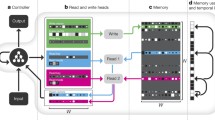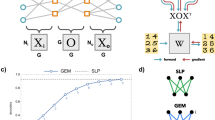Abstract
In nature, some phenomena are so complicated (complex) that they are difficult to understand or to analyze in a formal manner, due to a great deal of uncertainties caused by inevitable noises. In this paper, we propose an open evolutionary architecture that has a great flexibility in representing information, and that possesses a rich potential for the evolution of a variety of behaviors that could significantly expand the problem domains to which neural computing is applicable. The proposed model is a mockup (abstract) system that consists of ambient grids and living nodes, which may interact with each other via various kinds of communication mechanisms. Experiment result shows that it takes advantages of system dynamics occurring in different levels to accomplish assigned tasks. It also shows the system exhibits certain degrees of robustness in dealing with noises generated in the environments.










Similar content being viewed by others
References
Benuskova L, Abraham WC (2007) STDP rule endowed with the BCM sliding threshold accounts for hippocampal heterosynaptic plasticity. J Comp Neurosci 22(2):129–133
Bi G-q, Poo M-m (2001) Synaptic modification by correlated activity: Hebb’s postulate revisited. Annu Rev Neurosci 24:139–166
Chen JC, Conrad M (1994) A multilevel neuromolecular architecture that uses the extradimensional bypass principle to facilitate evolutionary learning. Physica D 75:417–437
Chen JC, Conrad M (1997) Evolutionary learning with a neuronmolecular architechure: a biologically motivated approach to computational adaptability. Soft Comput 1:19–34
Conrad M (1983) Adaptability. Plenum Press, New York
Conrad M (1990) The geometry of evolution. BioSystems 24:61–81
Conrad M (1998) Quantum gravity and life. BioSystems 46(1–2):29–39
Haykin S (1999) Neural networks, 2nd edn. Prentice Hall, Englewood Cliffs
Horgan J (2004) The end of science revisited. Computer 37(1):37–43. doi:10.1109/MC.2004.1260723
Kampfner RR (2006) Adaptability and the integration of computer-based information processing into the dynamics of organizations. Biosystems 85(1):30–36
Kauffman SA (1990) Requirements for evolvability in complex systems: orderly dynamics and frozen components. Physica D 42(1–3):135–152
Kirby KG (2002) Biological adaptabilities and quantum entropies. BioSystems 64:33–41
Kirby KG, Conrad M (1984) The enzymatic neuron as a reaction–diffusion network of cyclic nucleotides. Bull Math Biol 46(5/6):765–783
Kirby KG, Conrad M (1986) Intraneuronal dynamics as a substrate for evolutionary learning. Physica D 22:205–215
Lee ES (1966) A theory of migration. Demography 3:47–57
Liberman EA, Minina SV, Shklovsky-Kordy NE, Conrad M (1982) Change of mechanical parameters as a possible means for information processing by the neuron. Biophysics 27:863–870
Liberman EA, Minina SV, Mjakotina OL, Shklovsky-Kordy NE, Conrad M (1985) Neuron generator potentials evoked by intracellular injection of cyclic nucleotides and mechanical distension. Brain Res 338(1):33–44
Lin YH, Chen JC, Huang CY (2009) Design and implementation of an artificial neuromolecular chip and its applications to pattern classification problems. Neurocomputing 72(13–15):2892–2901
May RM (1973) Stability and complexity in model eco-systems. Princeton University Press, NJ
McCulloch WS, Pitts W (1943) A logical calculus of ideas immanent in nervous activity. Bull Math Biophys 5:115–133
Meng Y, Jin Y, Yin J, Conforth M (2010) Human activity detection using spiking neural networks regulated by a gene regulatory network. In: International Joint Conference on Neural Networks (IJCNN), July 2010, pp 2232–2237, Barcelona
Pfaffmann JO, Conrad M (2000) Adaptive information processing in microtubule networks. BioSystems 55:47–57
Ravenstein EG (1889) The laws of migration. J Roy Stat Soc 52(2):241–305
Ugur A, Conrad M (2002) Techniques for enhancing neuronal evolvability. Neurocomputing 42(1–4):239–265
Werbos P (1992) The cytoskeleton: why it may be crucial to human learning and to neurocontrol. Nanobiology 1:75–95
Author information
Authors and Affiliations
Corresponding author
Rights and permissions
About this article
Cite this article
Huang, CY., Chen, JC. Assimilating and integrating network signals for solving some complex problems with a multiscale neural architecture. Soft Comput 16, 1–10 (2012). https://doi.org/10.1007/s00500-011-0729-9
Published:
Issue Date:
DOI: https://doi.org/10.1007/s00500-011-0729-9




